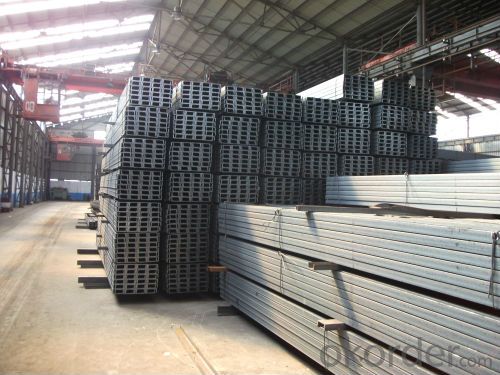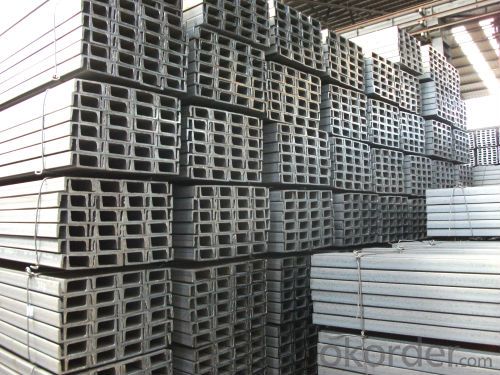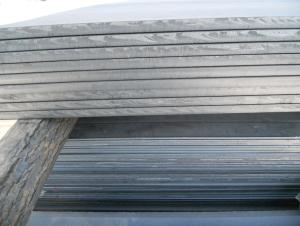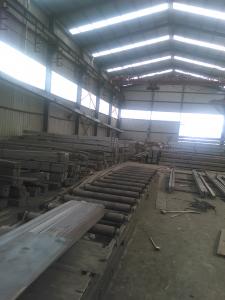GB-235 STEEL FLAT BAR
- Loading Port:
- China Main Port
- Payment Terms:
- TT or LC
- Min Order Qty:
- -
- Supply Capability:
- -
OKorder Service Pledge
OKorder Financial Service
You Might Also Like
Product Description:
OKorder is offering GB-235 STEEL FLAT BAR at great prices with worldwide shipping. Our supplier is a world-class manufacturer of steel, with our products utilized the world over. OKorder annually supplies products to European, North American and Asian markets. We provide quotations within 24 hours of receiving an inquiry and guarantee competitive prices.
Widely used for construction, Machinery manufacturing, Iron tower steel structure, Shipbuilding; Steel grating, Staircase, Bridge, Viaduct, Railway spare parts, Boilers making etc.
Packaging & Delivery of Steel Flat Bar
Packaging Details: The Steel Flat Bars are packed in bundles and loaded in 20 feet/40 feet container, or shipped by bulk cargo ,also we can do as customer's requirements.
Product Applications:
GB-235 STEEL FLAT BAR are ideal for structural applications and are widely used in the construction of buildings and bridges, and the manufacturing, petrochemical, and transportation industries.
Product Advantages:
OKorder's GB-235 STEEL FLAT BAR are durable, strong, and resist corrosion.
Main Product Features:
· Premium quality
· Prompt delivery & seaworthy packing (30 days after receiving deposit)
· Corrosion resistance
· Can be recycled and reused
· Mill test certification
· Professional Service
· Competitive pricing
Product Specifications:
Standard: GB
Material: Q235
Origin place: China
Thickness: 3mm-30mm
Width:20mm-200mm
Length: Max 12m
FAQ:
Q1: Why buy Materials & Equipment from OKorder.com?
A1: All products offered byOKorder.com are carefully selected from China's most reliable manufacturing enterprises. Through its ISO certifications, OKorder.com adheres to the highest standards and a commitment to supply chain safety and customer satisfaction.
Q2: How do we guarantee the quality of our products?
A2: We have established an advanced quality management system which conducts strict quality tests at every step, from raw materials to the final product. At the same time, we provide extensive follow-up service assurances as required.
Q3: Can stainless steel rust?
A3: Stainless does not "rust" as you think of regular steel rusting with a red oxide on the surface that flakes off. If you see red rust it is probably due to some iron particles that have contaminated the surface of the stainless steel and it is these iron particles that are rusting. Look at the source of the rusting and see if you can remove it from the surface.
Images:


- Q:How do you determine the ductility of a steel flat bar?
- To ascertain the ductility of a steel flat bar, there are several methods available. One commonly employed technique is the tensile test. During a tensile test, a sample of the steel flat bar is subjected to progressively increasing force until it reaches its breaking point. The test gauges the extent of deformation or elongation the bar undergoes before fracturing. Ductility is determined by calculating the percentage of elongation or reduction in the sample's area. Another approach is the bend test, wherein the steel flat bar is bent to a specific angle without experiencing any fractures. The angle at which the bar can be bent without breaking serves as an indicator of its ductility. Furthermore, the impact test evaluates the steel flat bar's ability to absorb energy under abrupt loading conditions. This test entails striking the sample with a pendulum-like apparatus and analyzing the amount of energy it absorbs before fracture occurs. The greater the energy absorbed, the more ductile the material is considered to be. In conclusion, the ductility of a steel flat bar can be determined by conducting various tests, including the tensile test, bend test, and impact test. These tests offer valuable insights into the material's capacity to deform without fracturing, thereby providing an assessment of its ductility.
- Q:How do steel flat bars perform under static loads?
- Steel flat bars are extensively utilized in numerous industries due to their exceptional strength and durability. The performance of these flat bars is highly commendable when exposed to static loads. Static loads pertain to loads that remain constant over time, such as the weight of structures or objects resting on the flat bars. Steel flat bars possess the ability to withstand these loads without experiencing significant deformation or failure. The remarkable tensile strength of steel facilitates the even distribution of applied loads across its surface, thereby minimizing stress concentrations. This characteristic ensures that steel flat bars can support heavy loads without bending or breaking. Furthermore, steel flat bars exhibit excellent resistance to deflection, meaning they retain their shape and remain stable under static loads. This property is of utmost importance in applications that demand a high level of structural integrity, including bridges, buildings, and machinery. Moreover, steel flat bars demonstrate superb fatigue resistance, enabling them to endure repeated loading and unloading cycles without weakening or fracturing. This advantage proves particularly advantageous in situations where the flat bars are exposed to dynamic loads or vibrations. To conclude, steel flat bars exhibit exceptional performance under static loads. Their high strength, resistance to deformation, and fatigue resistance make them an ideal choice for a wide range of applications that necessitate dependable and stable support.
- Q:Can steel flat bars be used in the manufacturing of machinery components?
- Steel flat bars are a viable option for the production of machinery components. Their strength, durability, and versatility make steel a widely used material in the manufacturing industry. When constructing machinery components like brackets, supports, frames, and base plates, steel flat bars are often the go-to choice. These bars provide a stable and robust foundation for different parts of the machinery, enabling them to withstand heavy loads and high pressures. Moreover, steel flat bars are easily machinable, weldable, and shapeable to meet specific dimensions, making them perfect for creating custom machinery components. All in all, steel flat bars offer a dependable and cost-efficient solution for manufacturing machinery components.
- Q:Are steel flat bars used in the aerospace industry?
- Yes, steel flat bars are commonly used in the aerospace industry. Steel is known for its strength and durability, making it an ideal material for various applications in aerospace engineering. Steel flat bars are often used in the manufacturing of aircraft components such as brackets, frames, and supports. These bars provide structural stability and support, ensuring the integrity and safety of the aircraft. Additionally, steel flat bars offer excellent resistance to corrosion and high temperatures, which are essential qualities for aerospace applications. Overall, steel flat bars are an essential material in the aerospace industry, playing a crucial role in the construction and performance of aircraft.
- Q:Can steel flat bars be galvanized or coated with other materials?
- Yes, steel flat bars can be galvanized or coated with other materials. Galvanization is a process in which a protective layer of zinc is applied to the surface of the steel to prevent corrosion. This can be done by either hot-dip galvanizing, where the steel is dipped in molten zinc, or by electroplating, where a zinc coating is applied through an electrochemical process. Apart from galvanization, steel flat bars can also be coated with other materials for various purposes. These coatings can provide additional protection against corrosion, improve aesthetic appearance, or enhance specific properties of the steel. Some common coating materials used for steel flat bars include epoxy, polyurethane, powder coating, and paint. These coatings can be applied through different methods, such as spraying, dipping, or powder coating, depending on the specific requirements and desired outcome. The choice of coating material and method depends on various factors, such as the intended use of the steel flat bars, the environment in which they will be used, and the desired appearance or performance characteristics. It is important to consult with experts or professionals in the field to determine the most suitable coating option for your specific needs.
- Q:How do steel flat bars compare to other materials like concrete or glass?
- Steel flat bars possess several advantages over alternative materials such as concrete or glass. To begin with, steel flat bars exhibit exceptional strength and durability. Boasting a high tensile strength, they can endure heavy loads and resist deformation. In contrast, concrete excels in compression but falters in tension, while glass is brittle and prone to breakage. When considering structural applications, steel flat bars prove to be a significantly more dependable and long-lasting option. Furthermore, steel flat bars provide versatility in terms of design and construction. They can be easily manipulated into various shapes and sizes, rendering them suitable for a wide array of applications. Conversely, concrete necessitates intricate formwork and curing procedures, whereas glass often faces limitations regarding size and shape. Steel flat bars offer greater design flexibility and can be conveniently modified or adjusted when necessary. In addition, steel flat bars exhibit excellent thermal conductivity, rendering them ideal for applications where heat transfer is crucial. Conversely, concrete and glass possess lower thermal conductivity and are less efficient in transferring heat. This quality positions steel flat bars as the preferred choice for applications such as heat exchangers or structural components in buildings that require meticulous temperature control. Moreover, steel flat bars boast superior fire resistance compared to concrete or glass. They can endure high temperatures for extended periods without compromising their structural integrity. Concrete tends to crack and spall under extreme heat, while glass can shatter or melt. Steel flat bars provide exceptional fire resistance, making them a safer option for applications that prioritize fire protection. In conclusion, steel flat bars offer an abundance of advantages over materials like concrete or glass. They exhibit greater strength, versatility, enhanced thermal conductivity, and heightened resistance to fire. These qualities establish steel flat bars as the preferred choice for an array of applications, ranging from structural construction to industrial equipment.
- Q:How do steel flat bars contribute to the overall efficiency of healthcare structures?
- Several factors contribute to the overall efficiency of healthcare structures, and steel flat bars are a significant element in achieving this. Firstly, the utilization of steel flat bars in the construction of healthcare facilities is widespread due to their exceptional strength and durability. This ensures that the buildings can withstand the test of time and provide a secure and safe environment for patients, staff, and equipment. Moreover, the versatility of steel flat bars allows for easy fabrication into various shapes and sizes, enabling efficient and precise construction. This flexibility enables healthcare structures to be designed and constructed according to specific requirements, optimizing the utilization of space and resources. Additionally, the fire resistance properties of steel flat bars are of utmost importance in healthcare structures, where the safety of occupants is a priority. By incorporating steel flat bars into the construction process, healthcare facilities can effectively minimize the risk of fire incidents and ensure the protection of patients and staff. Furthermore, the high load-bearing capacity of steel flat bars is essential in healthcare structures that require support for heavy equipment and machinery. This enables the buildings to accommodate advanced medical technology and infrastructure, such as MRI machines, surgical equipment, and patient lifts, without compromising the structural integrity. Lastly, the low-maintenance nature and resistance to corrosion of steel flat bars result in reduced need for frequent repairs and replacements. This not only saves costs but also minimizes disruptions to healthcare services, allowing medical professionals to focus on delivering quality care to patients. In conclusion, steel flat bars play a vital role in enhancing the efficiency of healthcare structures by providing strength, versatility, fire resistance, load-bearing capacity, and low-maintenance characteristics.
- Q:How can steel flat bars be protected from rusting?
- Steel flat bars can be protected from rusting through various methods: 1. Coating: Applying a protective coating on the surface of the steel flat bars is one of the most common and effective ways to prevent rusting. There are several types of coatings available, such as paint, powder coating, or galvanizing. These coatings act as a barrier between the steel and moisture in the environment, preventing the formation of rust. 2. Varnishing: Similar to coating, varnishing can provide a protective layer on the steel flat bars. Varnish is often used for decorative purposes, but it can also help in preventing rust by sealing the steel's surface and preventing moisture from coming into contact with it. 3. Oil or Wax: Applying a thin layer of oil or wax on the surface of the steel flat bars can provide protection against rust. The oil or wax acts as a barrier, preventing oxygen and moisture from reaching the steel and causing corrosion. Regular reapplication may be necessary, especially in outdoor or humid environments. 4. Rust Inhibitors: Rust inhibitors are chemical compounds that can be applied to the steel flat bars to prevent rust formation. These inhibitors work by forming a protective layer on the steel's surface or by neutralizing the chemical reactions that lead to rust. They can be applied as a spray, dip, or by adding them to a protective coating. 5. Proper Storage: Storing steel flat bars in a dry and well-ventilated area can help prevent rusting. Moisture is one of the main culprits for rust formation, so keeping the bars away from damp areas or direct contact with water is crucial. Using a dehumidifier or moisture-absorbing packets in storage areas can also help maintain a dry environment. 6. Regular Cleaning and Maintenance: Regularly cleaning the steel flat bars and removing any dirt, dust, or other contaminants can help prevent rust formation. Additionally, inspecting the bars for any signs of rust and promptly addressing the issue can prevent it from spreading and causing further damage. By employing these protective measures, steel flat bars can be effectively shielded from rusting, ensuring their durability and longevity.
- Q:What is the cost of steel flat bars compared to other materials?
- The cost of steel flat bars is generally lower compared to other materials such as aluminum or stainless steel.
- Q:How do I calculate the weight of a steel flat bar?
- To calculate the weight of a steel flat bar, you need to know its dimensions and the density of steel. The weight of an object can be determined by multiplying its volume by its density. 1. Measure the length, width, and thickness of the steel flat bar in inches or any other unit of measurement. 2. Convert the measurements to the same unit, if necessary, for consistency. 3. Calculate the volume of the flat bar by multiplying the length, width, and thickness of the steel flat bar. The formula is Volume = Length x Width x Thickness. 4. Look up the density of steel in pounds per cubic inch or any other unit of measurement. The density of steel is approximately 0.2836 pounds per cubic inch. 5. Multiply the volume of the flat bar by the density of steel to obtain the weight. The formula is Weight = Volume x Density. By following these steps, you can accurately calculate the weight of a steel flat bar based on its dimensions and the density of steel.
1. Manufacturer Overview |
|
|---|---|
| Location | |
| Year Established | |
| Annual Output Value | |
| Main Markets | |
| Company Certifications | |
2. Manufacturer Certificates |
|
|---|---|
| a) Certification Name | |
| Range | |
| Reference | |
| Validity Period | |
3. Manufacturer Capability |
|
|---|---|
| a)Trade Capacity | |
| Nearest Port | |
| Export Percentage | |
| No.of Employees in Trade Department | |
| Language Spoken: | |
| b)Factory Information | |
| Factory Size: | |
| No. of Production Lines | |
| Contract Manufacturing | |
| Product Price Range | |
Send your message to us
GB-235 STEEL FLAT BAR
- Loading Port:
- China Main Port
- Payment Terms:
- TT or LC
- Min Order Qty:
- -
- Supply Capability:
- -
OKorder Service Pledge
OKorder Financial Service
Similar products
New products
Hot products
Hot Searches
Related keywords






























